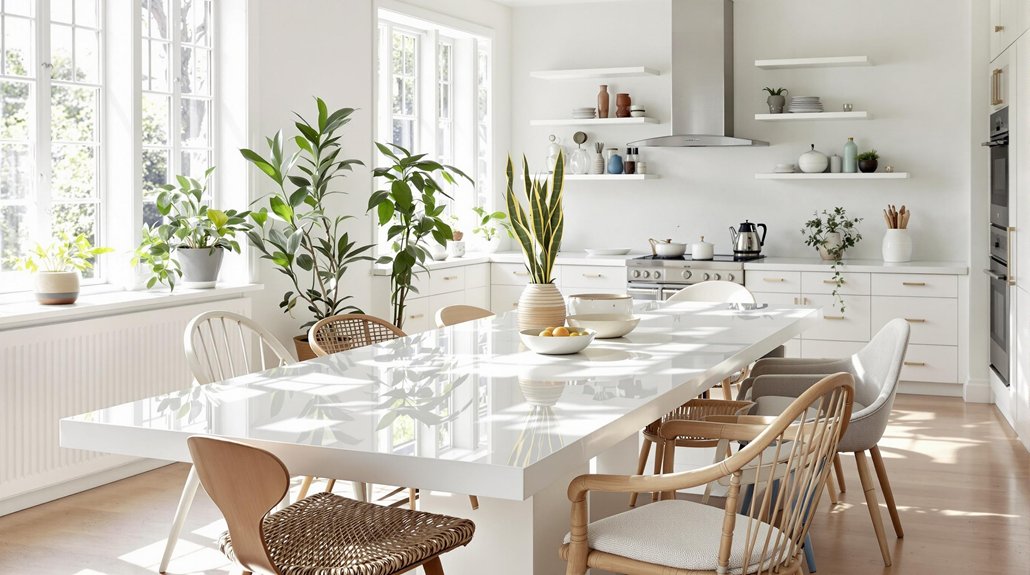
20 White Kitchen Table and Chairs Ideas for a Fresh and Inviting Look
A white kitchen table offers a luminous, adaptable centerpiece for any dining space. Pairings with natural wood, rattan, or industrial metal chairs add warmth, texture, or urban edge. Bold-colored seating creates dynamic contrast, while all-white sets reflect modern minimalism. Accents like mirrors, glass pieces, or seasonal decor maximize light and ambiance. High-gloss surfaces and oak combinations suit both contemporary and country-inspired spaces. Further inspiration explores textural play, antique-modern mixes, and visual layering for truly inviting kitchens.
Key Takeaways
- Pair a white kitchen table with natural wood or rattan chairs to add warmth and organic texture to the dining space.
- Use bold-colored or patterned chairs alongside a white table for a fresh, dynamic look that defines the room’s personality.
- Choose all-white dining sets or high-gloss white tables for a sleek, modern, and light-enhancing effect in your kitchen.
- Mix white tables with industrial-style metal or clear acrylic chairs to create contemporary contrast and visual interest.
- Accessorize with seasonal décor, soft cushions, or floral centerpieces to keep the white table setting inviting and updated year-round.
Pairing White Tables With Natural Wood Chairs
When combining a white kitchen table with natural wood chairs, the interplay between crisp, clean surfaces and organic textures introduces a striking visual contrast that is both modern and timeless. This pairing uplifts white dining sets by infusing them with warmth and tactile interest, counterbalancing the cool neutrality of white with the inviting tones of natural wood. The versatility of this combination accommodates a spectrum of design languages—whether the table features a lacquered modern finish or a distressed farmhouse aesthetic, natural wood chairs anchor the ensemble with authenticity. Aligning chair wood tones with cabinetry or flooring maintains visual cohesion, while the neutral base of white dining sets allows for effortless seasonal styling. This approach not only enhances spatial openness but also exemplifies current kitchen design sensibilities. Incorporating wooden accents in the dining area enhances the overall warmth and adds a cozy, welcoming atmosphere.
Modern Minimalism With All-White Dining Sets
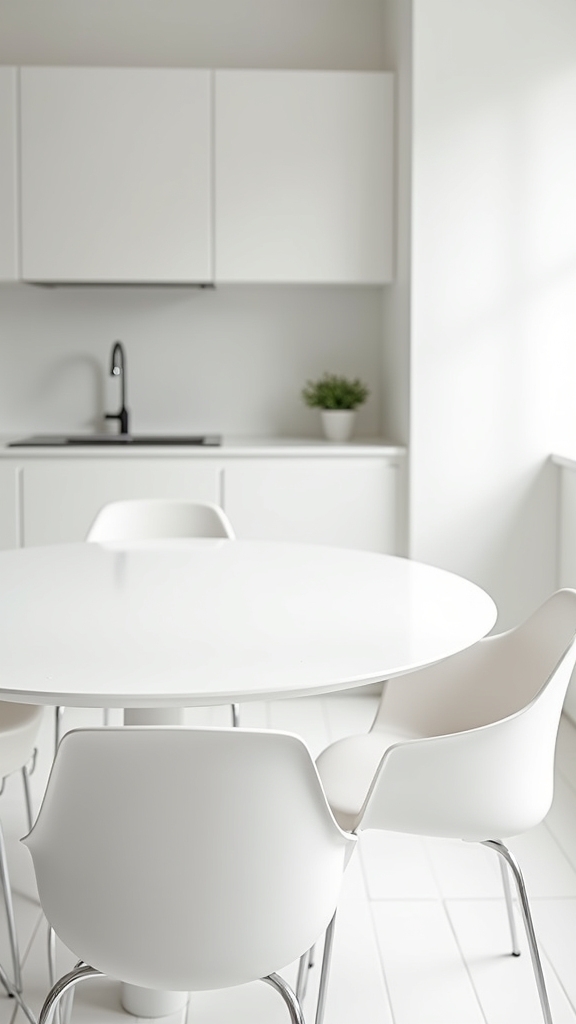
While the interplay of white tables and natural wood chairs introduces organic warmth, modern minimalism takes a purist approach with all-white dining sets. This trend in modern dining emphasizes clean lines, monochromatic palettes, and a serene spatial experience.
All-white dining furniture enhances visual openness and serves as a versatile foundation for various design sensibilities, from Scandinavian to urban contemporary. High-gloss white surfaces reflect natural and artificial light, amplifying brightness and imparting a refined elegance.
All-white dining furniture creates visual spaciousness and refined elegance, offering a luminous backdrop for any modern design aesthetic.
The minimalist aesthetic remains adaptable, allowing subtle textural contrasts or seasonal accessories for curated interest.
- Pristine white dining tables with crisp, angular silhouettes
- Sleek, high-gloss table surfaces amplifying natural light
- Streamlined white chairs echoing modernist simplicity
- Minimalist place settings in subtle off-white tones
- Subtle wood or stone accents to soften the ensemble
Modern dining, distilled to its essence, feels effortlessly enhanced.
Mixing White Tables With Bold-Colored Chairs
A striking visual strategy in contemporary dining design involves pairing a crisp white table with bold-colored chairs, infusing the space with dynamic contrast and curated vibrancy. This approach leverages the white table’s neutrality as a backdrop, allowing accent chairs in saturated hues—such as purple, red, or pink—to command attention and define the room’s character.
In the area of white dining room ideas, this juxtaposition enhances both elements, fostering a fresh, inviting ambiance. Designers often extend this concept by integrating coordinated accessories, like vibrant table linens or glassware, to unify the color palette.
Significantly, this trend offers adaptability; changing chair colors can instantly update the aesthetic, making it a practical yet impactful solution for evolving tastes within modern dining environments.
Creating a Country Look With White and Oak
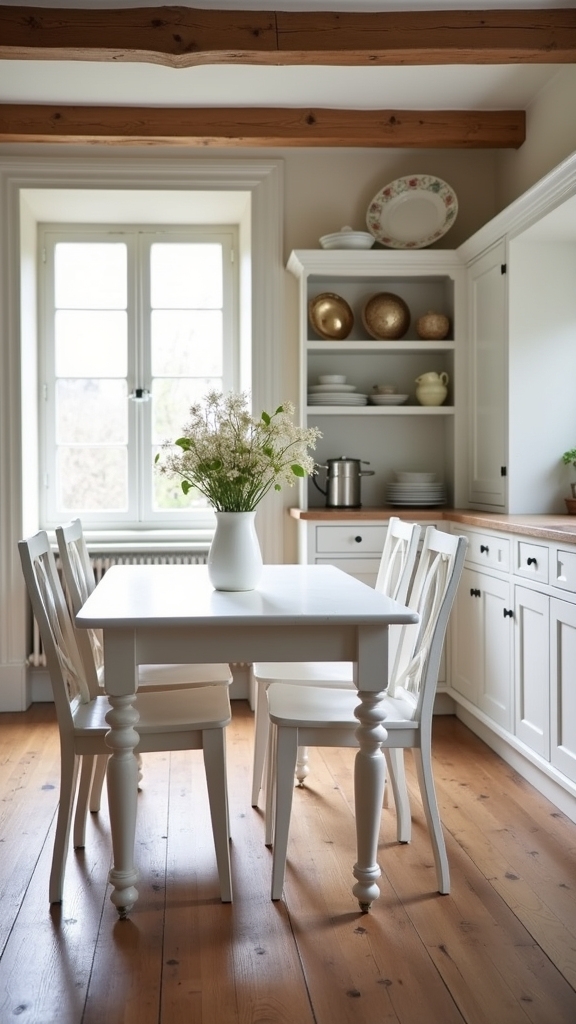
Combining crisp white finishes with the warmth of oak introduces an inviting country aesthetic, blending classic appeal with contemporary brightness. The strategic use of rustic elements—such as rattan mats and vintage-inspired textiles—enhances visual interest while reinforcing the farmhouse trend. Layering gingham patterns and subtle textures adds depth, transforming the space into a cohesive and charming focal point. Incorporating cream cabinetry into the design can further enhance the kitchen’s warmth, providing a versatile foundation for various stylistic choices.
Pairing White With Wood
Blending the crisp clarity of a white kitchen table with the organic warmth of oak chairs instantly cultivates a refined country aesthetic that resonates with both traditional charm and contemporary sensibility.
This pairing enhances the white dining room table as a focal point, while the texture and hue of solid oak chairs ground the space in rustic authenticity.
The juxtaposition of bright surfaces and natural wood tones orchestrates a harmonious color palette, ideal for amplifying natural light and enhancing spatial perception.
Such versatility makes this combination a perennial favorite among design experts.
- Pristine white table surfaces reflecting sunlight for enhanced spaciousness
- Sturdy oak chairs introducing tactile contrast and visual depth
- Subtle grain patterns enriching the overall composition
- White table linens merging seamlessly for layered sophistication
- Adaptable palette easily refreshed with seasonal accents
Accentuating With Rustic Decor
Many design-forward kitchens achieve a timeless country aesthetic by layering rustic decor onto the foundational pairing of a white table and solid oak chairs. The juxtaposition of a white dining room table and oak seating delivers a sophisticated yet approachable contrast, enhancing the room’s warmth and echoing rural influences. Incorporating rattan placemats, gingham linens, or wicker seat cushions further amplifies this effect, creating a tactile and visually dynamic environment. Colorful crockery or hand-carved wooden centerpieces displayed on the white dining room table provide focal points that reinforce the rustic motif. Below, key elements are summarized:
| Feature | Material Example | Effect on Space |
|---|---|---|
| Oak Chairs | Solid Oak | Natural Warmth |
| Patterned Linens | Gingham/Floral | Homey Visual Interest |
| Rustic Accessories | Rattan/Wicker | Layered Texture |
Blending Patterns and Texture
Building upon the tactile richness of rustic decor, a thoughtfully curated mix of patterns and textures enhances the synergy between white kitchen tables and oak chairs.
This interplay is foundational in crafting a country-inspired aesthetic within dining room furniture, where contrast and cohesion coexist. Key design strategies include the integration of soft and hard materials, layered visually and physically, to evoke warmth and authenticity.
Trending elements such as patterned linens, organic accessories, and contrasting finishes establish a dynamic yet harmonious ambiance.
- Gingham or floral table linens introduce vibrant, nostalgic motifs atop crisp white surfaces.
- Oak chairs paired with white leather seats merge tradition with modern comfort.
- Solid oak table tops dressed with rattan mats offer organic texture and depth.
- Woven baskets serve as decorative or functional centerpieces.
- Ceramic dishware layered alongside wood and white provides tactile intrigue.
High-Gloss White Tables for a Sleek Design

How does one instantly raise a kitchen or dining area to reflect contemporary sophistication? The answer lies in the strategic use of high-gloss white tables. These statement pieces feature a lustrous, reflective surface—often crafted from MDF with a lacquer finish—that amplifies natural and artificial light, creating an illusion of expansiveness and modernity. The high gloss dining aesthetic is synonymous with sleek, uncluttered lines, making it a favored choice among designers aiming for minimalist or avant-garde interiors. Maintenance is straightforward: regular cleaning with a damp cloth preserves the immaculate sheen, while avoiding abrasives prevents scratches. For a visually compelling contrast, pairing high-gloss white tables with matte black or vibrantly colored chairs injects striking dynamism, ensuring the dining space remains at the forefront of current design trends. Incorporating textural accents in black and white kitchens enhances visual layering, elevating the overall design.
Adding Texture With Rattan or Woven Chairs
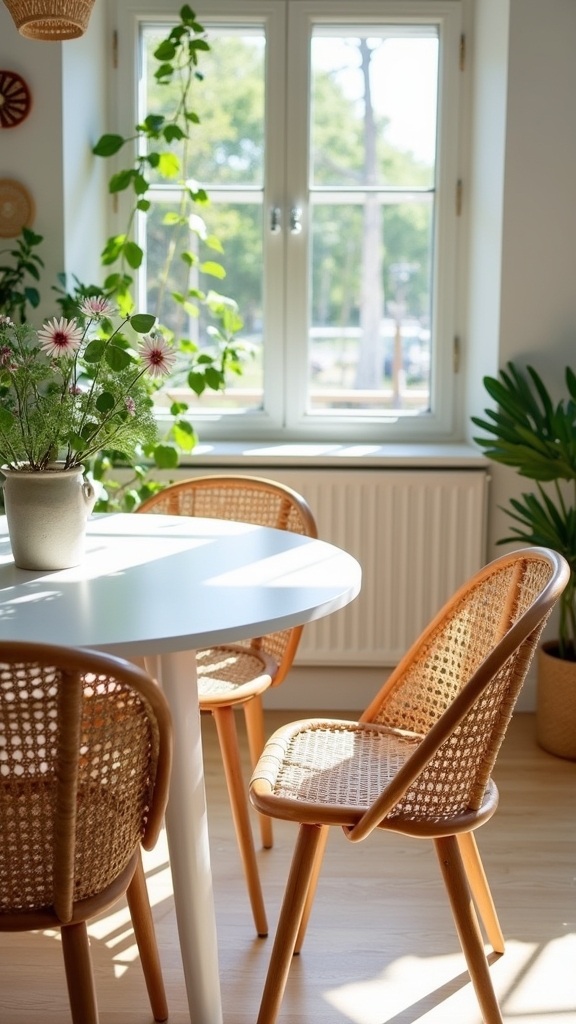
In contemporary kitchen design, rattan chairs introduce essential warmth to the crisp profile of a white table, balancing minimalism with tactile intrigue. Woven accents amplify visual depth, creating dynamic interplay between organic fibers and smooth surfaces. This textured approach reflects current trends favoring natural materials and layered contrasts within modern interiors. Additionally, incorporating reclaimed wood countertops can enhance the rustic-modern aesthetic, adding character and warmth to the overall kitchen design.
Rattan Chairs Enhance Warmth
A touch of rattan or woven texture instantly enhances the visual warmth of a white kitchen table, introducing organic character that breaks up the starkness of an all-white palette.
Rattan dining chairs are celebrated for their natural appeal and adaptability, offering both tactile interest and a contemporary edge. Designers favor these materials for their ability to soften sharp lines and create a welcoming, lived-in ambience.
Lightweight yet durable, rattan chairs seamlessly accommodate evolving seating needs while maintaining their structural integrity and style. Their versatility guarantees compatibility with minimalist, Scandinavian, or farmhouse settings.
Visualize:
- Sunlit mornings with woven dining chairs framing a crisp white table
- Subtle shadows cast by intricately woven patterns
- Effortless rearrangement for gatherings
- Neutral tones harmonizing with white surfaces
- A relaxed, inviting dining atmosphere for daily living
Woven Accents Add Depth
Enhance the tactile dimension of a white kitchen by introducing woven accents through rattan or intricately crafted chairs. Woven accents infuse essential texture and warmth, offsetting the crisp minimalism of white kitchen tables and chairs. The interplay of natural fibers with smooth surfaces creates a balanced aesthetic, uplifting both farmhouse charm and modern elegance. Versatile rattan chairs, available in a spectrum from contemporary to traditional, seamlessly integrate with white kitchen schemes, delivering visual intrigue without visual clutter. Breathable and ergonomic, these materials provide comfort for both formal and casual dining.
| Feeling Evoked | Design Impact |
|---|---|
| Inviting warmth | Layers of texture |
| Relaxed sophistication | Soften stark spaces |
| Welcoming ambiance | Raised visual depth |
Woven accents remain a definitive trend, harmonizing practicality and style in contemporary interiors.
White Table With Industrial-Style Metal Seating
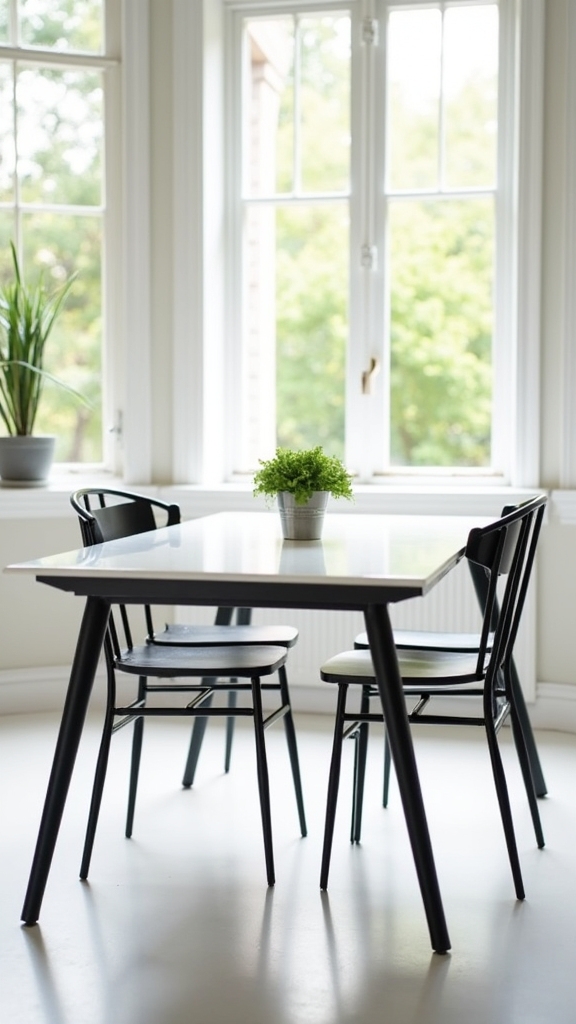
When paired with industrial-style metal seating, a white kitchen table establishes a visually dynamic interplay between crisp minimalism and urban edge. This juxtaposition of a white dining room table with raw, utilitarian metal chairs is gaining traction among trendsetters for its ability to bridge contemporary and rustic aesthetics.
The glossy surface of the table amplifies natural light, while the matte or brushed textures of metal seating inject tactile interest and durability. Minimalist silhouettes and exposed hardware underscore the industrial narrative, yet the overall composition remains inviting and versatile.
- Polished white table surfaces reflect ambient light, enhancing spatial brightness.
- Rugged metal chairs introduce architectural lines and authentic character.
- Neutral palettes serve as a canvas for seasonal décor or vibrant accents.
- Clean-lined designs guarantee seamless integration with open-plan kitchens.
- Optional colorful cushions provide personalized comfort and visual warmth.
Accentuating With Floral Centerpieces
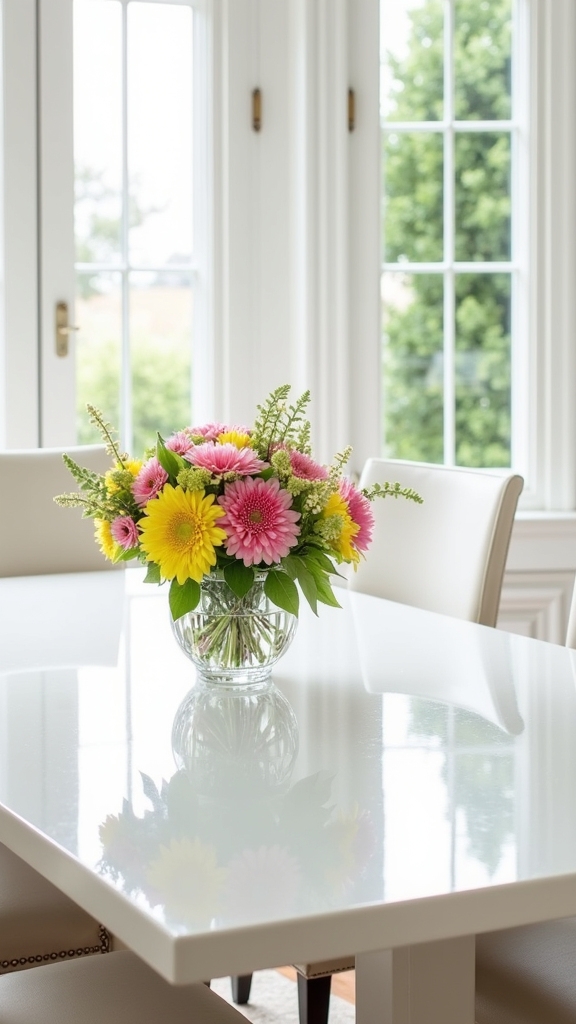
Balancing the industrial allure of metal seating and a pristine white kitchen table, floral centerpieces introduce organic vibrancy and visual softness to the setting.
Strategic selection of floral centerpieces—such as seasonal blooms like tulips in spring or sunflowers in summer—ensures the tablescape remains dynamic and attuned to current design trends.
Expert designers recommend minimalist vessels, favoring clear glass or white ceramic, to create cohesion and allow the flowers’ chromatic intensity to command attention.
Layering various flower heights and textures within a single arrangement generates visual depth, elevating the aesthetic impact.
Rotating these floral centerpieces regularly not only revitalizes the space, but also fosters a welcoming ambiance, making the white kitchen table an inviting hub for gatherings and enhancing the overall sensory experience.
Farmhouse Charm: White Table and Bench Seating
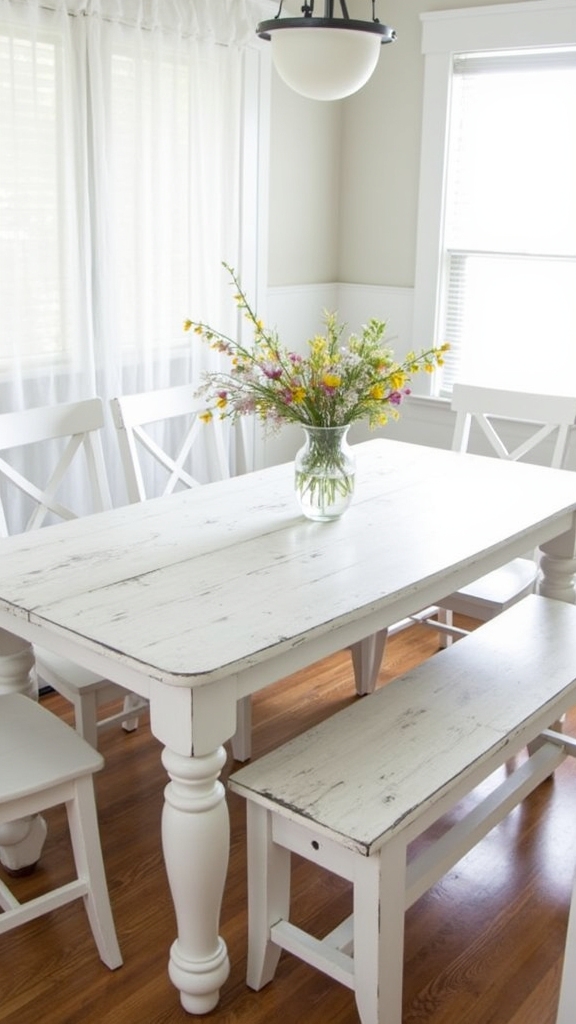
While contemporary kitchens often lean toward sleek minimalism, the integration of a white table with bench seating distinctly anchors the farmhouse aesthetic in both function and form.
This pairing captures the essence of rural hospitality, emphasizing a relaxed, communal atmosphere. A white dining room table with rustic wooden benches delivers timeless farmhouse charm while maximizing seating, ideal for lively family gatherings.
Distressed finishes on the table surface enhance visual warmth and authenticity, while thoughtful accessories—such as gingham or floral cushions—bring an inviting layer of color and texture.
The versatility of the white table and bench combination allows effortless adaptation for both everyday meals and larger occasions. The addition of vintage-inspired hardware on furniture accentuates the rustic charm and adds a unique touch to the dining area.
- Distressed white dining room table surfaces exude vintage appeal
- Sturdy wooden benches amplify rustic character
- Gingham or floral cushions introduce tactile interest
- Spacious seating fosters inclusive dining experiences
- Versatile arrangement adapts for guests and gatherings
Monochrome Magic: Black and White Dining Room
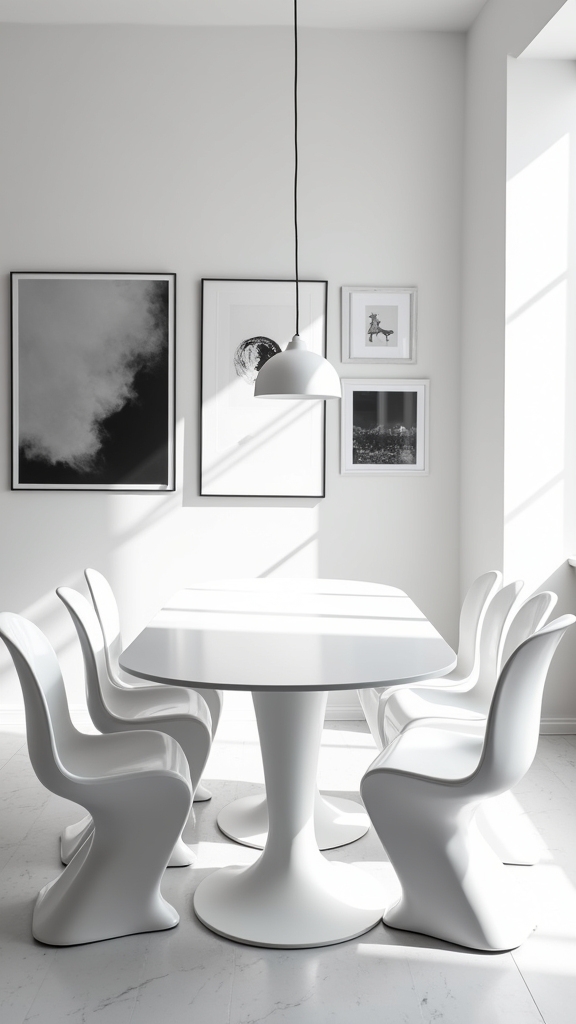
A monochrome black and white dining room leverages bold contrast, allowing crisp white tables to visually pop against the depth of matte black chairs or accent walls.
Current design trends emphasize the interplay of geometric patterns and layered textures—think houndstooth rugs or lattice table linens—to introduce dimension without straying from the strict color palette.
This interplay of form and finish creates a dining area that feels both avant-garde and timeless.
Bold Contrast With Furniture
For those seeking visual drama and contemporary sophistication, the black and white dining room remains an enduring interior trend. A white dining room table immediately commands attention when paired with bold contrast with furniture choices—matte black chairs and sleek black accents.
The interplay of glossy and matte finishes adds depth, while curated decor sharpens the monochrome effect. This approach is favored by designers for its ability to create an impactful yet harmonious space.
- High-gloss white dining room table framed by matte black chairs for a graphic silhouette
- Black accent wall as a backdrop, spotlighting crisp white furniture forms
- Contrasting textures: lacquered table surfaces meet soft, upholstered black seating
- Minimalist white floral arrangements in sculptural black vases
- Streamlined black and white accessories, reinforcing the bold, contemporary palette
Geometric Patterns and Textures
Harnessing the power of geometric patterns and varied textures instantly enhances a monochrome black and white dining room, transforming stark contrast into a dynamic visual narrative.
Expert designers leverage geometric rugs, table linens, and wall art with bold, intersecting lines to articulate visual rhythm and depth, making the interplay of black and white both enchanting and sophisticated.
High-gloss white dining tables juxtaposed with matte black chairs reinforce the monochrome aesthetic, while accessories such as geometric vases or angular light fixtures unify the theme with graphic precision.
Layered textures—like plush, black-and-white patterned cushions on streamlined white chairs—add tactile dimension without disrupting the restrained palette.
This approach to geometric patterns and textural diversity exemplifies current trends, delivering a space that feels both curated and unmistakably contemporary.
Incorporating Soft Furnishings and Cushions
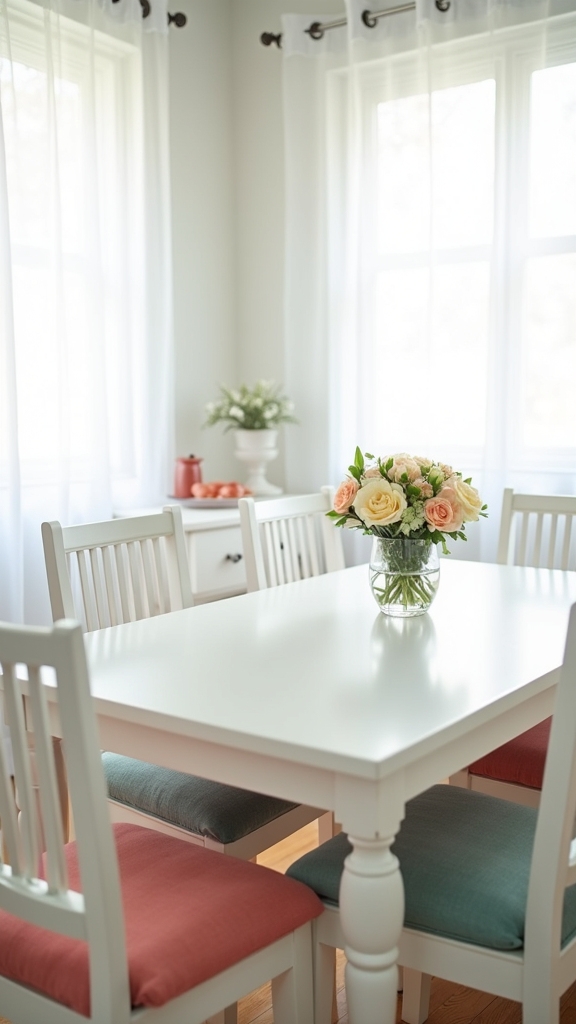
Soft furnishings introduce both tactile comfort and aesthetic depth to white kitchen tables and chairs, transforming a minimalist palette into an inviting focal point.
The strategic addition of cushions and throws not only raises ergonomic support but also infuses subtle warmth into the overall scheme. Designers favor layering soft furnishings in textural variety and seasonal hues, enhancing visual intrigue without disrupting the clean lines of white furniture. Incorporating geometric or floral patterns in cushions can add depth and personality, complementing the minimalist decor while maintaining a cohesive look.
Removable, durable fabrics guarantee practicality, accommodating the functional demands of an active kitchen environment. For ideal cohesion and style retention, secure cushions with ties or velcro to maintain precise placement.
- Linen cushions in muted earth tones for understated luxury
- Quilted seat pads with geometric stitching for tactile contrast
- Removable velvet covers in jewel tones for seasonal updates
- Patterned throws draped over chair backs for dynamic layering
- Cushions anchored with discreet ties for effortless elegance
Using White Furniture Against Dark Walls
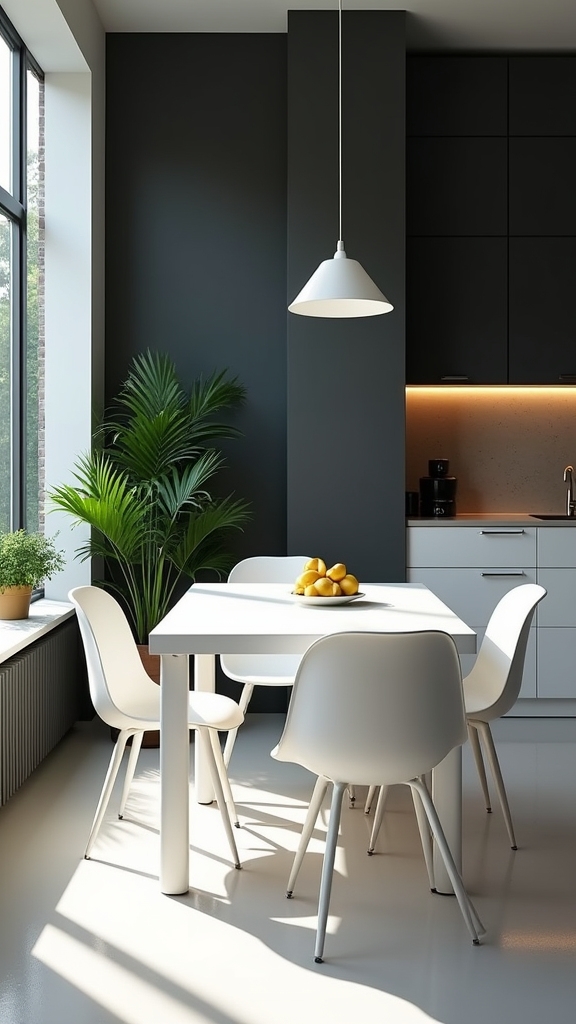
Contrast serves as a powerful design tool when white kitchen tables and chairs are set against dark walls, such as deep navy or charcoal gray.
The interplay between high gloss white dining furniture and bold, saturated backdrops generates immediate visual drama, amplifying both brightness and spatial perception.
White leather dining chairs are especially effective, introducing a sleek, contemporary edge while balancing the depth of dark walls.
For those preferring a softer aesthetic, white-washed wooden tables offer a subtle, shabby-chic charm that tempers the intensity of moody hues.
Incorporating layered lighting—pendant fixtures and floor lamps—ensures the white elements remain luminous, accentuating their crisp silhouette.
This approach aligns with contemporary design trends, where bold color contrasts and tactile finishes redefine modern dining environments with elegance and energy.
Scandinavian-Inspired White Dining Spaces
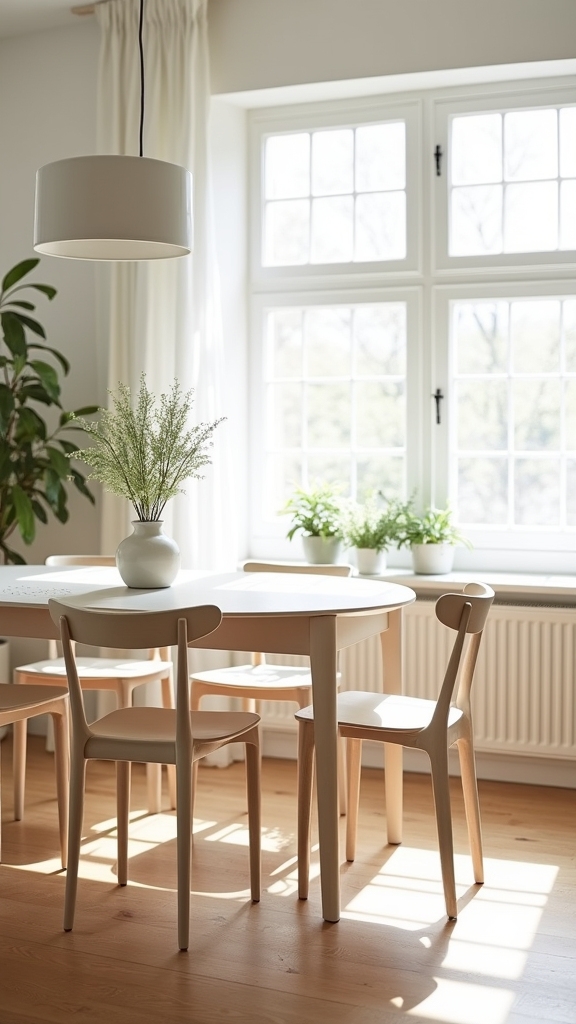
While many design trends come and go, Scandinavian-inspired white dining spaces remain a benchmark for refined minimalism and visual tranquility. The essence of Scandinavian design lies in its celebration of clean lines, natural materials, and functional beauty.
White dining tables and chairs, often crafted with light woods or sleek finishes, anchor these spaces with an airy sophistication. Subtle geometric accents and carefully curated textiles add layers of comfort and interest, without detracting from the understated elegance.
The following visual features typify this enduring trend:
- Crisp white dining tables paired with streamlined chairs
- Pale wood flooring and exposed grain finishes
- Soft wool or linen upholstery on chair seats
- Minimalist pendant lighting with sculptural silhouettes
- Strategic pops of color through art or ceramics
This approach guarantees a harmonious, timeless dining atmosphere.
Playing With Shape: Round and Oval White Tables
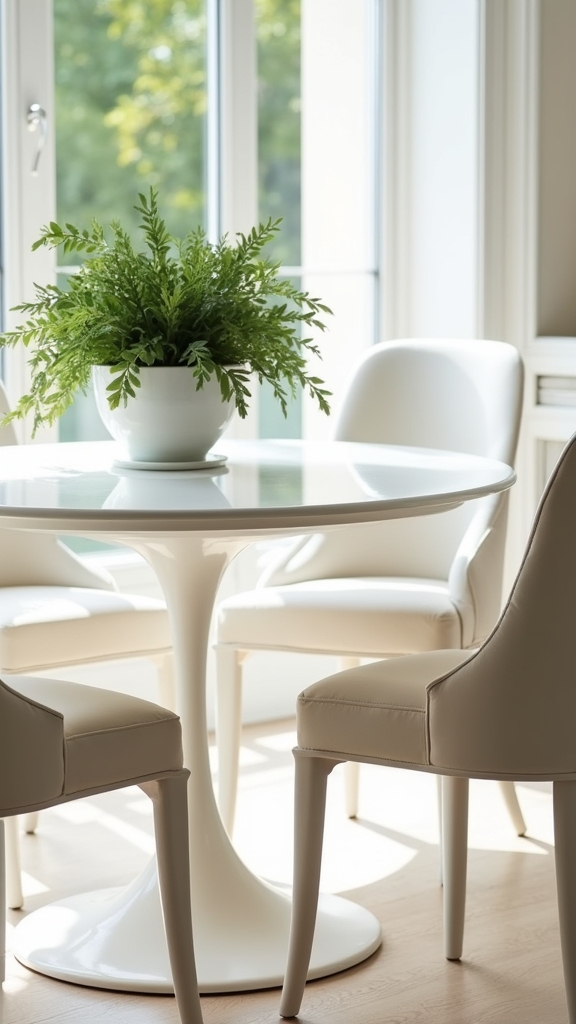
Round and oval white tables exemplify spatial efficiency, enhancing circulation in compact dining zones with their fluid, edge-free profiles.
These curved silhouettes not only facilitate seamless movement but also align with contemporary trends in maximizing usable square footage.
For designers aiming to achieve both intimacy and versatility, such configurations offer an ideal balance of functionality and visual lightness.
Maximizing Flow With Curves
By introducing curved silhouettes into a dining space, round and oval white tables exemplify both spatial efficiency and modern design sensibility.
These flowing forms not only enhance circulation but also reflect current trends favoring organic shapes and seamless shifts. The absence of angular edges in dining tables with glass or lacquered finishes raises both safety and visual purity, making them particularly well-suited for families and contemporary interiors.
Curved tables foster intimacy and inclusivity, ensuring every guest feels connected.
- Glossy white oval tables with glass tops reflect ambient light, amplifying brightness and modernity
- Rounded pedestal bases create unobstructed legroom, contributing to a minimalist aesthetic
- Soft silhouettes tuck elegantly into compact breakfast nooks
- No sharp corners, reducing hazards in child-friendly kitchens
- Unified seating arrangements encourage effortless conversations and communal dining
Space-Saving Table Solutions
Embracing spatial efficiency, designers increasingly turn to round and oval white tables as sophisticated solutions for compact dining areas.
These space-saving table solutions maximize functionality without sacrificing style, thanks to their absence of sharp corners, which not only optimize movement but also enhance safety—critical in family environments or tight layouts.
Round tables excel in intimate settings by promoting easy circulation and flexible seating, accommodating additional guests seamlessly.
Meanwhile, oval tables offer an elongated surface advantageous for serving, merging hosting versatility with a streamlined footprint.
The white finish amplifies natural light and visually expands the room, supporting a fresh and inviting kitchen aesthetic.
Many designs incorporate extendable features, adapting to everyday needs or special gatherings while maintaining an uncluttered, contemporary profile in modern interiors.
Layering With Neutral Rugs and Table Runners
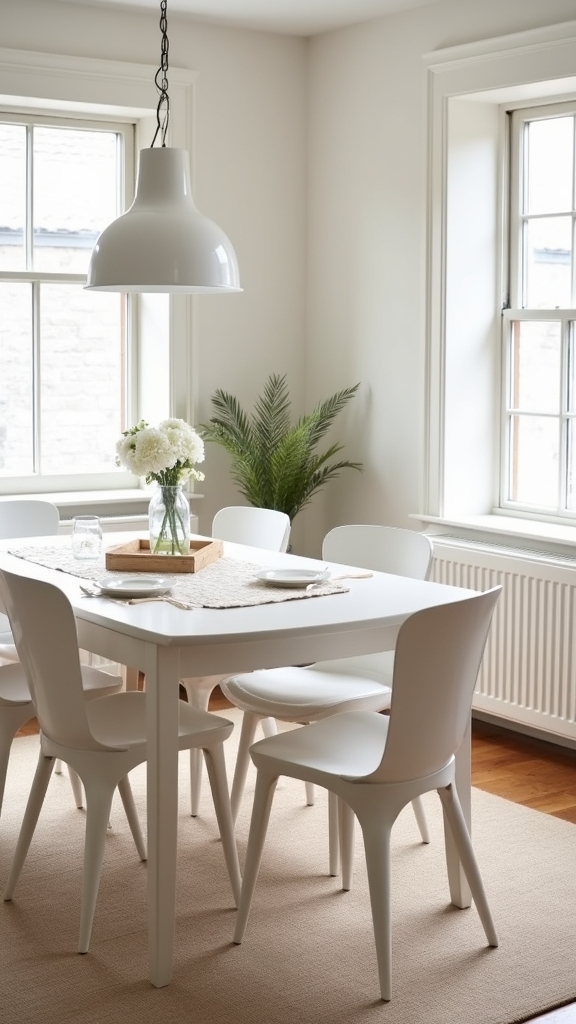
Although white kitchen tables and chairs evoke a sense of crisp minimalism, layering neutral rugs and table runners introduces strategic warmth and tactile dimension to the space.
Design experts recommend utilizing subtle earth tones and texture-rich materials to enhance the inviting quality of a white-dominated dining zone. Neutral rugs in shades like beige, taupe, or light gray create a grounded foundation, while linen or cotton table runners add nuanced pattern and practical elegance.
This dual approach guarantees cohesive visual flow and functional durability. Consider the following layered combinations for maximum impact:
- Soft beige rugs anchoring the table area
- Light gray runners with understated geometric patterns
- Taupe flatweave rugs for textural interest
- Linen runners in creamy neutrals for refined simplicity
- Coordinated layering of neutral hues for a harmonious effect
Displaying Colorful Crockery on White Tables
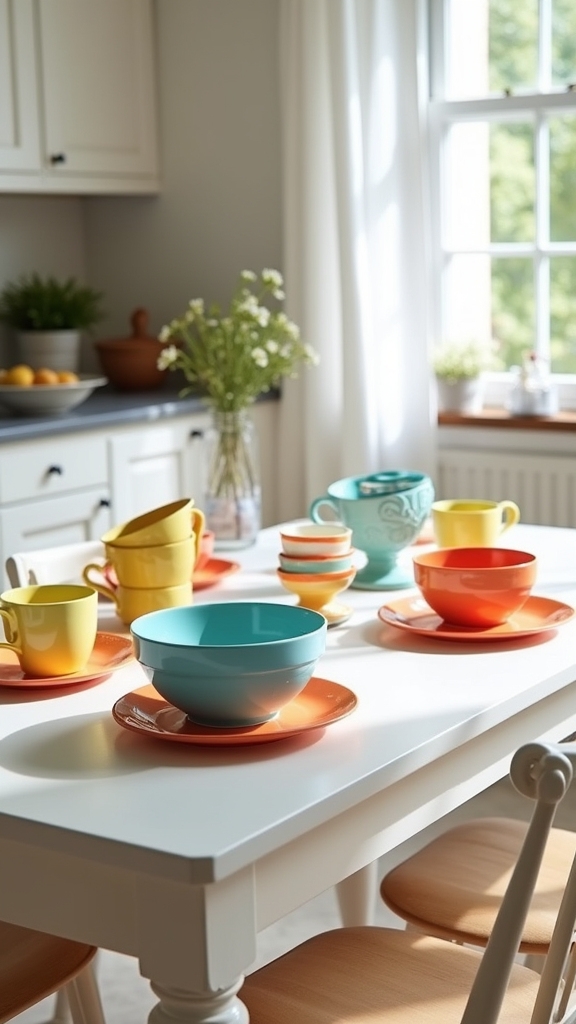
Displaying vibrant crockery on a white kitchen table transforms everyday dining into a curated visual statement, with bold hues and intricate patterns commanding attention as a dynamic centerpiece.
Current trends emphasize the intentional mixing of patterns and color palettes, creating depth and a sense of curated eclecticism.
This approach not only enlivens the minimalist backdrop but also reinforces the table’s role as an expressive focal point in contemporary interiors.
Vibrant Crockery as Centerpiece
When vibrant crockery is arranged atop a white kitchen table, the interplay of saturated hues against a crisp, neutral surface creates an immediate focal point imbued with visual dynamism.
This design approach leverages the power of contrast, allowing the vibrant crockery to project personality and warmth into a minimalist setting. Expert stylists often recommend rotating seasonal dishware, ensuring the dining space remains perpetually fresh and in vogue.
The reflective qualities of colored glassware augment the chromatic impact, introducing a sophisticated dimension. For those seeking a lively, inviting atmosphere, the strategic display of such crockery is transformative.
- Lush turquoise plates radiating against a pristine table
- Lemon-yellow bowls adding a pop of sunshine
- Ruby-red glassware reflecting ambient light
- Contemporary serving platters with geometric motifs
- Seasonal floral designs infusing organic vibrancy
Mixing Patterns and Hues
Building upon the dynamic energy introduced by vibrant crockery, the practice of mixing patterns and hues enhances the visual intrigue of a white kitchen table. This contemporary approach leverages the crisp neutrality of the white surface to amplify the impact of colorful tableware, allowing geometric motifs, floral accents, and solid tones to coexist in an eclectic, layered tableau.
Current design trends advocate for intentional juxtaposition—balancing oversized patterned platters with minimalist bowls or small accent plates—to prevent visual clutter while maintaining cohesion. The strategic use of white linens or placemats further refines the presentation, accentuating chromatic contrasts and ensuring an enhanced, harmonious tablescape.
This method of mixing patterns and hues not only personalizes the dining area but also delivers a lively, curated aesthetic reflective of modern style sensibilities.
Choosing White Leather or Fabric Dining Chairs
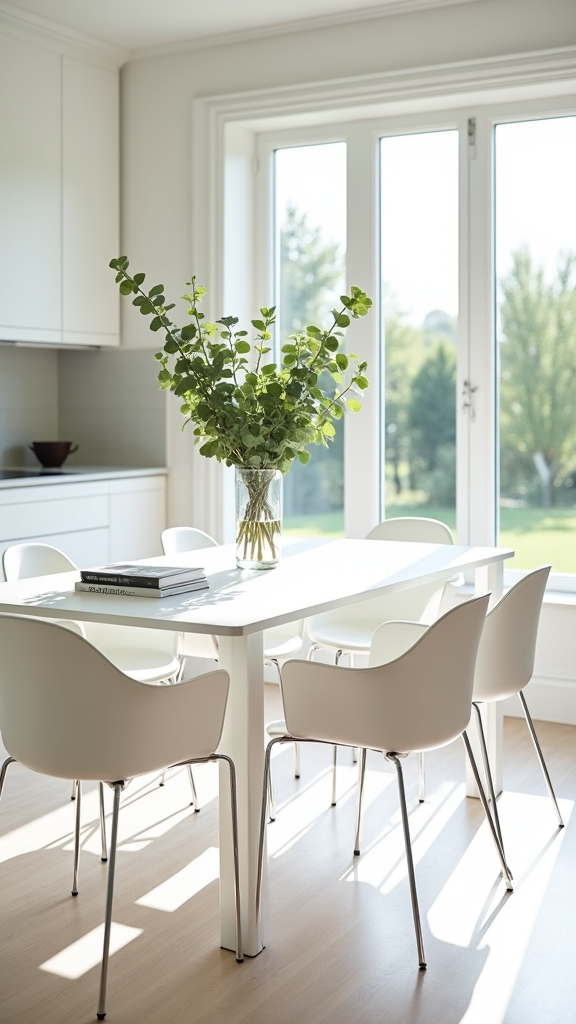
As homeowners seek to enhance their dining spaces with a crisp, modern edge, the choice between white leather and fabric dining chairs becomes pivotal in both function and style.
White leather dining chairs evoke a sleek, contemporary ambiance—ideal for those prioritizing a luxurious visual impact and effortless maintenance. In contrast, fabric dining chairs in white introduce tactile warmth and a relaxed, inviting character, perfect for family-centric environments.
Considerations extend beyond aesthetics: durability and ease of cleaning are essential, particularly in active kitchens. High-quality upholstery guarantees longevity, while mixing chair types raises spatial interest.
- Polished white leather surfaces reflecting ambient light
- Plush white fabric dining chairs for a softer, layered look
- Contrasting textures creating subtle visual intrigue
- Streamlined silhouettes in leather for minimalism
- Tufted or patterned fabric upholstery adding dimension
Enhancing Light With Mirrors and Glass Accents
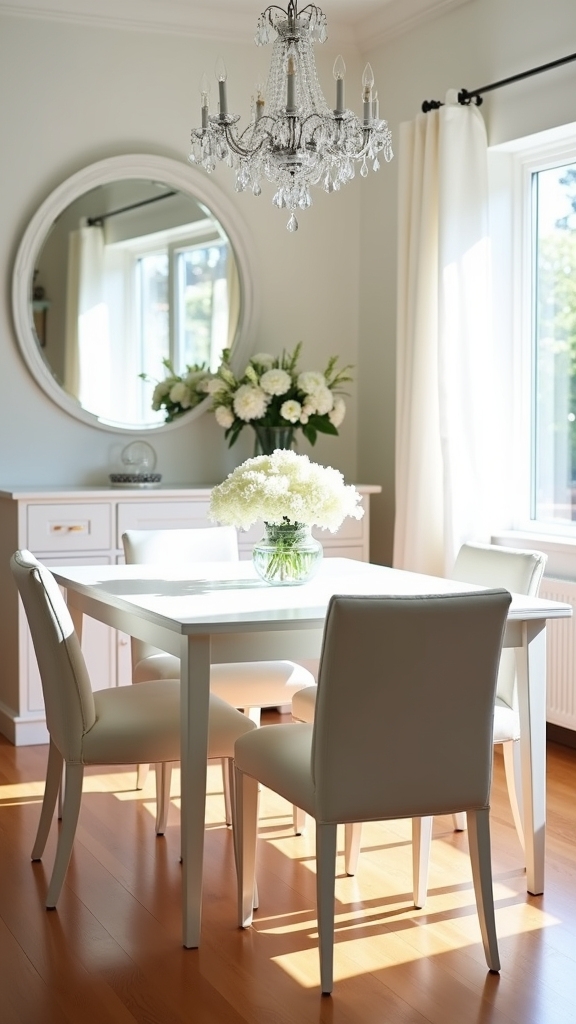
By integrating mirrors and glass accents, a white kitchen table and chairs arrangement achieves an enhanced sense of luminosity and spatial breadth.
Mirrors, strategically positioned opposite windows, reflect daylight to amplify brightness and create the illusion of a more expansive dining space.
Glass accents—such as vases, pendant light fixtures, or even a glass-topped table—introduce transparency and refract light, reinforcing the airy, inviting quality that defines contemporary white dining furniture trends.
Utilizing clear acrylic chairs with a white dining table exemplifies the modern penchant for uncluttered, visually light environments, allowing illumination to flow unimpeded.
These design approaches not only raise the spatial perception but also align with current preferences for minimalism and subtle sophistication, ensuring a dining area feels open, fresh, and inherently welcoming.
Seasonal Decor for White Kitchen Tables
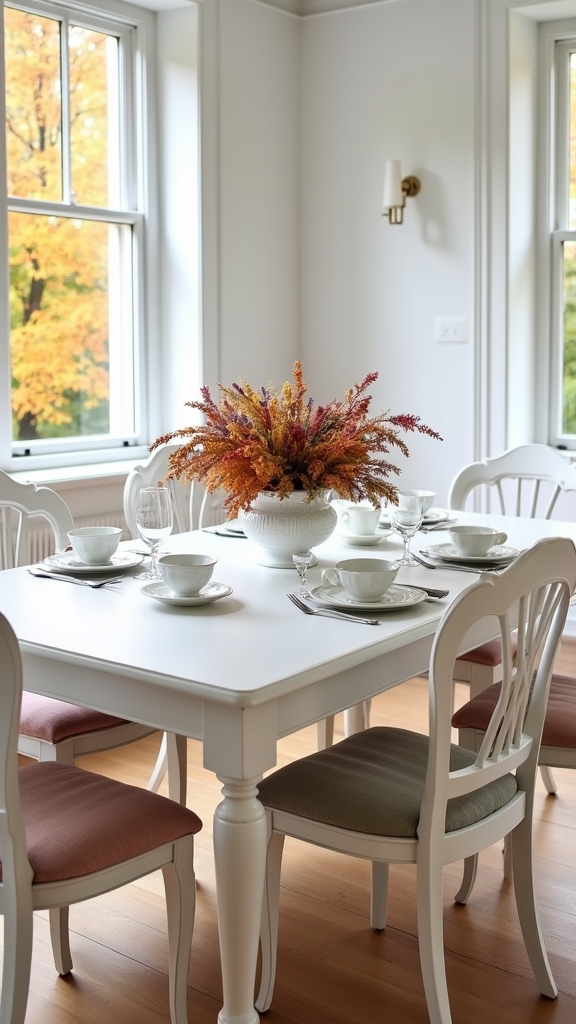
While the inherent versatility of a white kitchen table provides a refined canvas, seasonal décor introduces dynamic visual interest and timely sophistication.
Seasonal decor for white kitchen tables leverages the pristine backdrop to amplify color, texture, and thematic resonance with each passing season.
Expert stylists recommend rotating accents to create a refreshed environment, aligning the table’s ambiance with current trends and natural cycles.
Strategic layering of textiles, botanicals, and accessories guarantees that the table remains both functional and visually compelling year-round.
Incorporating reflective surfaces can also enhance the seasonal ambiance by amplifying natural light and creating a brighter atmosphere.
Consider the following seasonal enhancements:
- Pastel floral arrangements in spring for a delicate, airy effect
- Gingham or plaid table runners for texture and warmth in autumn
- Pumpkin or pinecone centerpieces as festive winter focal points
- Decorative bowls brimming with seasonal fruits or vegetables
- Swapping plates and mugs to reflect summer brightness or winter coziness
Mixing Antique and Contemporary White Furniture

Although often perceived as disparate design areas, antique and contemporary white furniture, when thoughtfully combined, yield an enhanced dining space defined by both character and sophistication.
The juxtaposition of antique white furniture with its ornate detailing and artisanal craftsmanship against the streamlined silhouettes of contemporary pieces introduces a compelling visual dichotomy. To achieve cohesion, design experts recommend selecting a unified white palette—perhaps blending antique white with a complementary modern white—to prevent visual dissonance.
Layering textures plays a critical role: a distressed antique table paired with minimalist, lacquered chairs infuses depth and tactile interest. The inclusion of contemporary decorative items or sleek tableware acts as a stylistic bridge, ensuring the overall dining space remains fresh, inviting, and on-trend while honoring both traditional and modern influences.
Frequently Asked Questions
What Color Dining Chairs With White Table?
Selecting chair color for a white table depends on desired ambiance: grey chairs evoke monochrome sophistication, black offers contrast, wooden introduces rustic warmth, while vibrant or pastel tones create visual interest, aligning with contemporary design trends for personalized aesthetics.
What Do I Put in the Middle of My Dining Table?
When considering a Table Centerpiece, current trends favor organic elements such as fresh floral arrangements in sculptural vases, layered with textured runners or placemats, and complemented by mixed-height candles or decorative bowls for a visually dynamic, curated tablescape.
How Can I Make My Kitchen Table Look New?
For a thorough Table Refresh, one should apply premium paint in trending neutral tones, incorporate on-trend textured runners, introduce sculptural centerpieces, and select contrasting chair materials. Regular surface maintenance preserves visual impact and extends the table’s contemporary appeal.
How Can I Make My Dining Room More Inviting?
To make a dining room more inviting, experts recommend layering cozy accents—think textured textiles, ambient lighting, and personalized décor. Trend-forward spaces integrate warm hues, plush seating, and tactile elements to enhance comfort, visual interest, and welcoming ambiance.
Conclusion
A white kitchen table and chairs ensemble remains a timeless centerpiece, offering unparalleled versatility and visual clarity. By integrating natural woods, bold hues, reflective surfaces, or high-gloss finishes, homeowners can tailor this classic palette to embody modern minimalism, rustic warmth, or eclectic sophistication. Attuned to current design trends, the strategic layering of textures and accents—from mirrors to seasonal décor—ensures these white dining spaces continue to evoke freshness, openness, and refined style in any contemporary home.
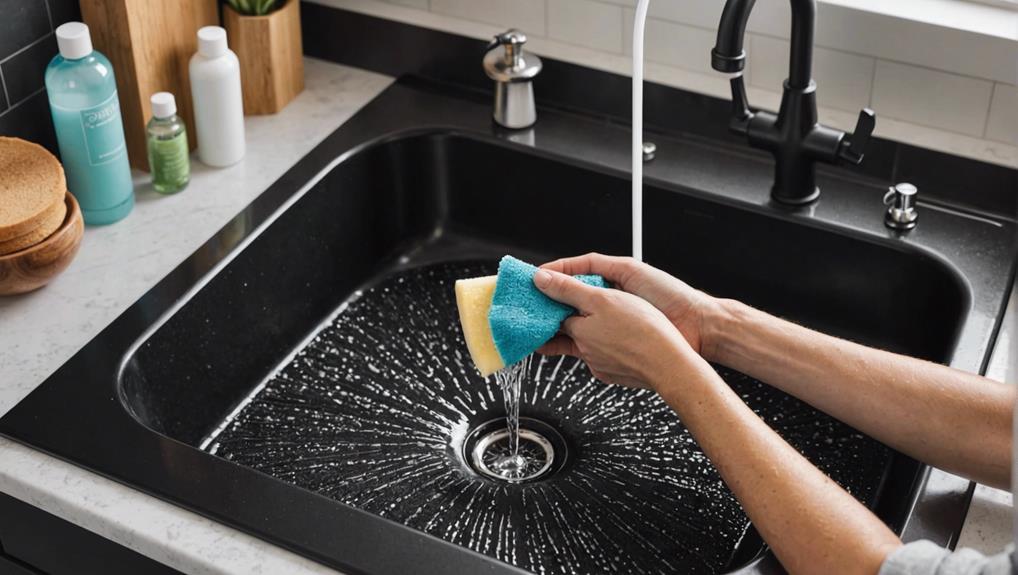
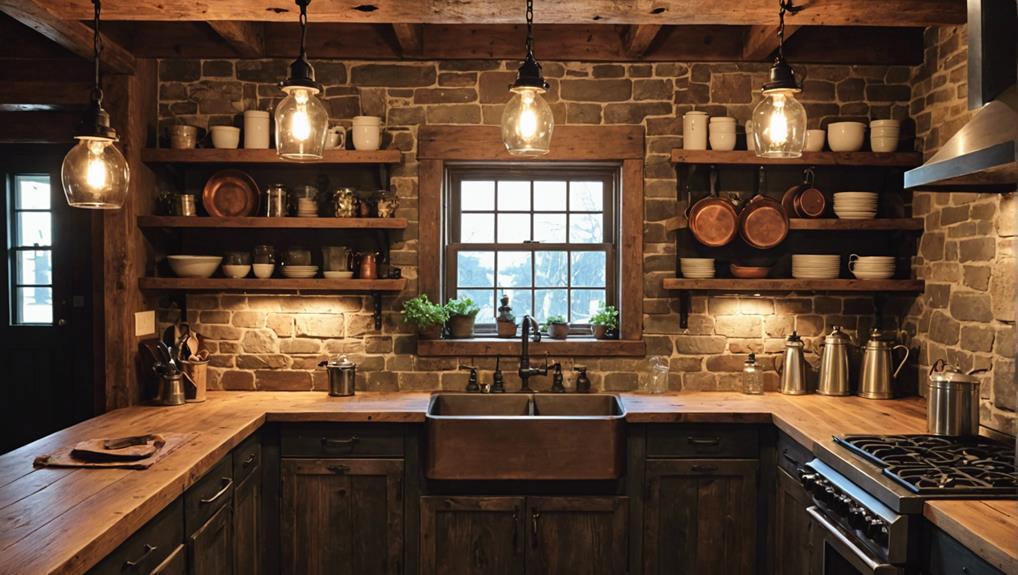
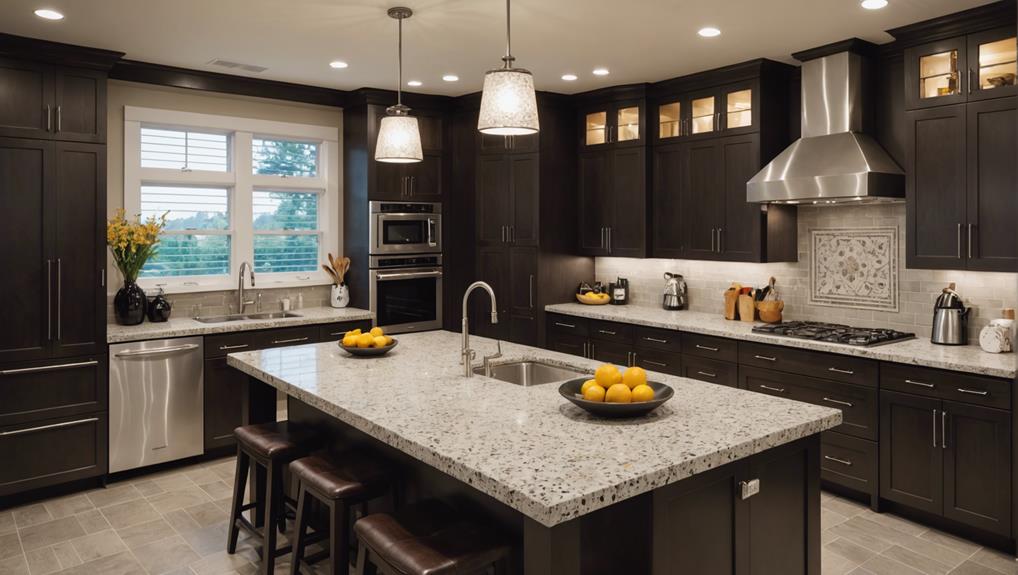
Leave a Reply